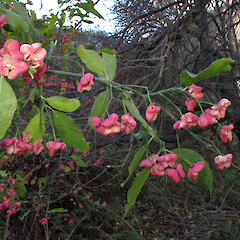Euonymus europaeus
Common name
spindle tree
Family
Celastraceae
Flora category
Vascular – Exotic
Structural class
Trees & Shrubs - Dicotyledons
NVS code
The National Vegetation Survey (NVS) Databank is a physical archive and electronic databank containing records of over 94,000 vegetation survey plots - including data from over 19,000 permanent plots. NVS maintains a standard set of species code abbreviations that correspond to standard scientific plant names from the Ngä Tipu o Aotearoa - New Zealand Plants database.
EUOEUR
Conservation status
Not applicable
Habitat
Terrestrial.
Detailed description
Much-branched glabrous, deciduous shrub or small tree up to 6m high. Bark grey & smooth. Twigs green, quadrangular, smooth, not winged. Leaves opposite, ovate-lanceolate to elliptic, acute or acuminate, crenate, usually turning red in autumn, 2–10cm long; petiole 6–12mm long. Cymes 2–15-flowered, pedunculate, dichotomous. Buds greenish, usually 4-angled; flowers usually 4-merous, 8–10mm diam.; petals greenish-yellow, generally oblong, widely separated. Capsule 4-lobed, deep pink, exposing the bright orange aril after opening. (- Webb et. al., 1988)
Flowering
November, December
Flower colours
Green, Yellow
Fruiting
March to May
Life cycle
Perennial. Long-lived seed bank - more than a year (Carol West, pers. comm.). The species is gynodioecious (2 sexual morphs: 1 strictly female and the other, termed male, producing some seed) with both sexes established in wild populations (Webb et al., 1988). Birds (ibid.).
Year naturalised
1958
Origin
Europe
Reason for introduction
Ornamental
Etymology
euonymus: One possible explanation is this genus is named after Euonyme, the mother of the Furies (vengeance deities in Greek mythology) because of the irritating properties of this plant. Another explanation is that the name is simply from the Greek eu ‘good’ and onoma ‘name’, meaning ‘a name of good repute’.
Poisonous plant
All parts of this tree are poisonous including the pink fruits with orange seed.








